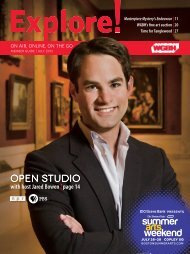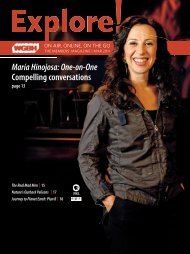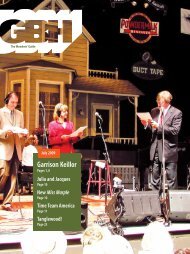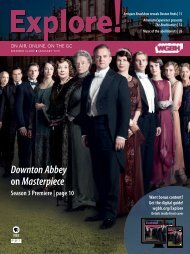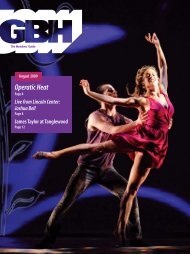Download program notes and libretto - WGBH
Download program notes and libretto - WGBH
Download program notes and libretto - WGBH
Create successful ePaper yourself
Turn your PDF publications into a flip-book with our unique Google optimized e-Paper software.
likely attempting to describe a lira da braccio, the Renaissance<br />
instrument closely associated with Orpheus <strong>and</strong> with<br />
recitations of poetry by humanists. This type of lira, a sevenstring<br />
chordal instrument played with a bow, died out in the<br />
early seventeenth century, <strong>and</strong> in 1688, when Steffani chose<br />
to evoke its sound to depict Amphion’s lira, it was an attempt,<br />
supported by the illusion of the music from the hidden viols,<br />
to reconstruct the mythical sound of the antique lyre.<br />
This scene of Amphion <strong>and</strong> the harmony of spheres was, in<br />
the context of Niobe, an expression of the intellectual<br />
ambition of Amphion, <strong>and</strong> it made a great impression on<br />
Pietro Torri, a composer who arrived in Munich in 1687.<br />
Later, in 1716,Torri presented Max Emanuel with the cantata<br />
La Reggia dell’Armonia, in which Anfione’s solo aria with its<br />
quartet of hidden viols is interpolated completely <strong>and</strong> without<br />
modification. To make his cantata about Harmony, Torri<br />
f e s t i va l o p e ra<br />
added the character of Il Tempo (Father Time), <strong>and</strong> wrote a<br />
dialogue between Anfione <strong>and</strong> Il Tempo. More than twenty<br />
years after Niobe, Regina di Tebe, Torri was paying homage<br />
to its timeless expression of the Harmony of the Spheres,<br />
associating the fame of Amphion, the mythic musician of the<br />
antiquity, with the art of Steffani, the influential composer of<br />
the reign of Maximilian Emanuel. This new context, created<br />
by extracting this extraordinary piece of music from its<br />
original dramatic setting, was freed from the tragic ends of<br />
Amphion <strong>and</strong> Niobe, bringing it back instead to its original<br />
allegory of the eternal power of music. ■<br />
—Gilbert Blin<br />
BEMF Stage Director in Residence<br />
143<br />
2 0 1 1 b o s t o n e a r l y m u s i c f e s t i v a l<br />
NIOBE, REGINA DI TEBE












